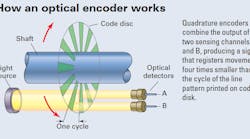The sensing mechanism in an incremental optical rotary encoder consists primarily of a light source, code wheel, and optical detector. As the code wheel turns, a ring of alternating opaque and transparent regions shutters the light between the source and detector, creating a series of pulses.
Questions & Answers
Q: What is the resolution of a 1,000-line encoder?
A: The base resolution is 0.360°. Resolution obtainable by quadrature signaling is four times better, or 0.090°. Electronic interpolation – mathematically predicting position between data points – can achieve even higher resolutions.
Q: How is direction encoded in quadrature signals?
A: In the typical quadrature relationship, counterclockwise (CCW) rotation causes the signal designated as “A” to lead the one designated “B.” B leading A, on the other hand, indicates clockwise (CW) rotation.


